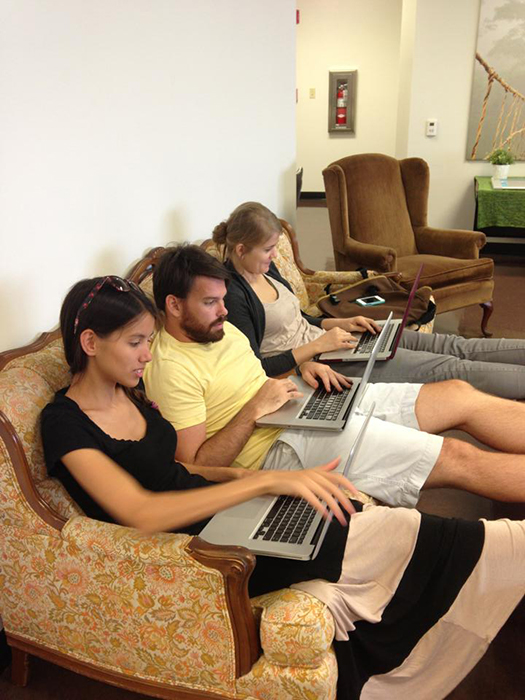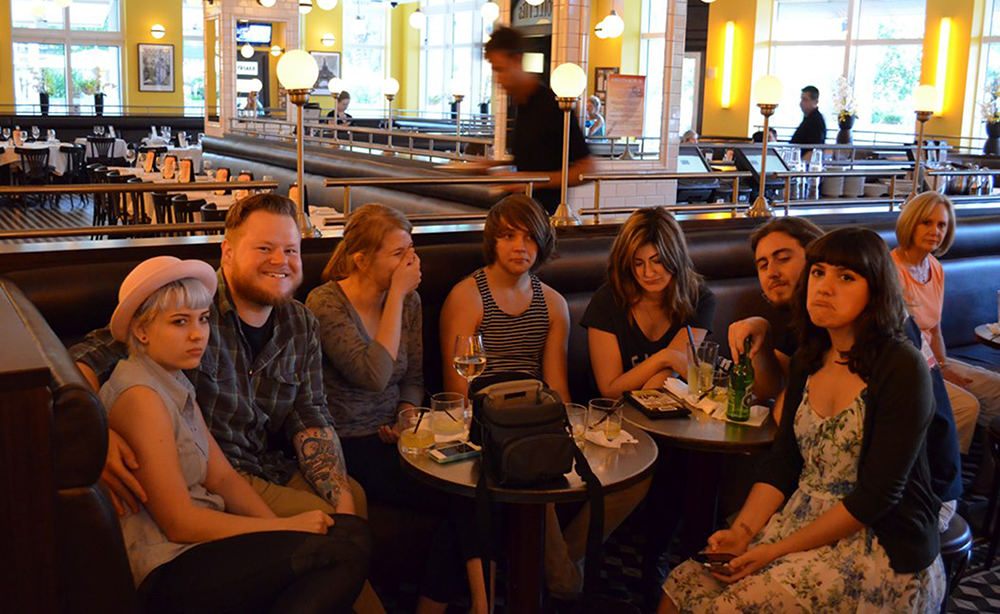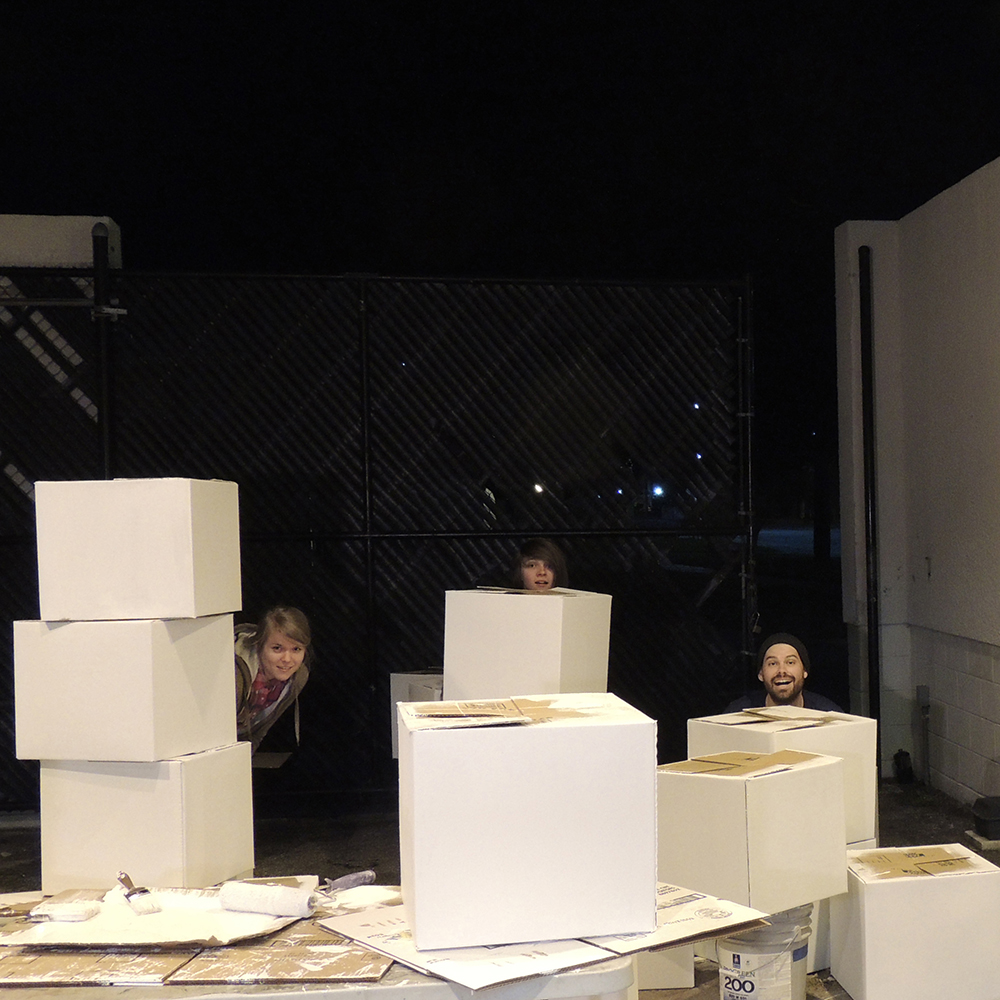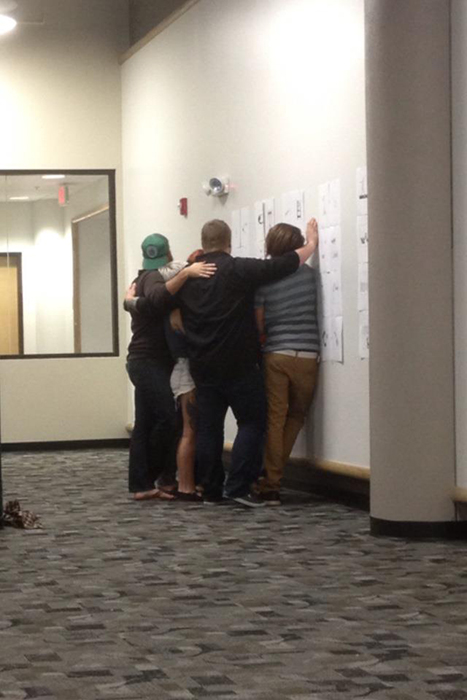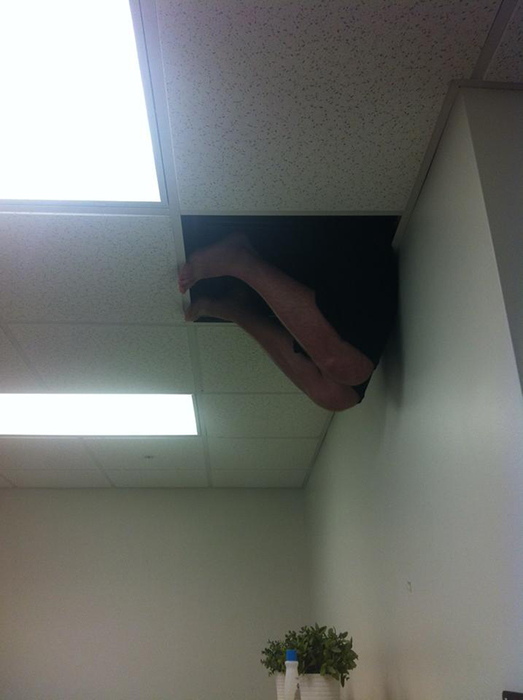“When we were juniors, our last class of the week ended on thursdays at 6 PM, and Happy Hour usually runs from 4 to 7 pm. All of us did that every single thursday, and that really strengthened our bond as a little family unit.”—Jimmy Breen
Jimmy Breen: Graphic Design BFA Alum, University of South Florida / St.Petersburg FL
jimmybreen.com
“when we were juniors, our last class of the week ended on thursdays at 6 PM, and happy hour usually runs from 4 to 7 pm. all of us did that every single thursday, and that really strengthened our bond as a little family unit.”—jimmy breen
How would you describe the collaborative group?
Our class was unlike any other that I have ever had. And, I don’t mean course. I mean, the group of people. From the beginning, everyone cooperated and was helpful to each other.
There is an element of competition that is inherent to design students. It’s similar to the arrogance seen in Ivy League students. Design students are in competition to be the best. That wasn’t the case with our class, because the stronger students, which included me, agreed that they wanted to improve the program as a whole. We wanted to improve our classmates’ ability as a whole. We knew students were valuable teachers to each other. Those types of peer-to-peer experiences, things that you learn along the way, are often overlooked. Students think of themselves as only learning from professors, but there is so much to learn from your peers. That was something that we established and encouraged early on and shaped our class dynamic.
Does the size of a design program affect how students group together?
Definitely. We had a small group. When you have less than twenty students, and these are the same faces that you see everyday for a couple of years, people are more willing to invest in one another. Other majors with larger programs generally have a more liquid student body; students pick and choose which classes they want and when they want them. Because our program is so small, classes only run once a year, spread across the same three professors. Everyone is in the same classes at the same time. That changes people’s mindset. People really get to know one another because nobody’s going anywhere. We were like a family.
Dibs
courtesy of usfsp gd class of 2014
I had been in a number of majors before settling on graphic design. In every single one of those courses, everyone kept their heads down, did their own thing, then went on their own way. Sometimes you attach to one person, maybe two, because you might have them in another course. But from semester to semester, you have new classes and have to start the process of learning new people from scratch. I did computer programming for a while, but I felt so alone in those classes. Everyone was doing the same formulaic thing, but even then, there was no camaraderie. Unlike larger programs, our graphic design class was able to grow together because of the smaller structure. Even the competitive people, who thought they were better than everyone else, grew because of that dynamic. Students look out for their peers, they respect the things their peers say, and they are more familiar with the work that their peers are doing.
Is it good to bring outsider perspectives into a small program?
It depends. There was an instance during our final semester, in our Senior Thesis course, where we had a couple of people come in from the community to look at our work halfway through the project. Every student in the class had already established what they were doing; they had already hashed ideas out with peers, the professor, and themselves. Everyone was familiar with everyone’s thought processes, backgrounds, interests, etc. These guest critics had never seen anything we had done before, and their responses were to immediately change everything. They wanted to change the core idea. But we weren’t in the conceptual developmental stage; we were far past that. The critics had fantastic feedback and advice that was essentially worthless, because they were critiquing a solution that we had established in the first week.
Are visiting artist workshops more beneficial?
I think that’s the only instance where outside perspectives are helpful in school. When students get a glimpse at the way an artist works, they learn a different method of working. For example, when Ryan Shelley came in and gave a workshop on printmaking with cardboard plates, that was beneficial because none of us had ever done anything like that. It made us look at materials differently. It made us rethink printmaking processes. If a program brings in a visiting designer, it is better to focus on their work, because it gives students an impression of something that they haven’t seen before, and that is a more positive, helpful experience.
How did your class build a sense of familiarity and cohesion?
Before we started in the graphic design program, a small group of four or five of us were friends and knew each other pretty well, especially Alex Maldonado and myself. Alex and I noticed that the class ahead of ours wasn’t really doing much, and we didn’t want that to happen to our class. We took it upon ourselves to help steer the program, and we imposed ourselves as a positive influence. We immediately made friends with everyone. When we had time after classes to go do things, we would. We had some bonding moments, things that we did for fun as a class.
For better and for worse, the administration at USF also largely influenced our “togetherness.” We fought the university on some very serious issues, which absolutely strengthened us. I don’t think students stand up for anything as much as they used to in the past. Even more detailed considerations, like scheduling, affected our ability to physically get together. As juniors, our schedule really worked out well, and alternatively, scheduling was what disbanded us as seniors. When we were juniors, our last class of the week ended on Thursdays at 6 PM, and Happy Hour usually runs from 4 to 7 PM. All of us did that every single Thursday, and that really strengthened our bond as a little family unit. We knew the bartender, so he would give us good deals, and for those of us who weren’t 21, they could still go because it was a restaurant. Also, every semester we had an end-of-semester dinner. We would rent out a room at a really nice restaurant, get dressed up, and have fun as a family. It’s an important thing for people to have time to enjoy themselves away from work, or in our case, the classroom. We knew everything about each other. Getting to know everyone helped us trust each other. When we were seniors, our schedules destroyed that. Our last class let out on Thursday at noon. Of course everybody was like, “I want to go home, eat food, and take a nap.” Some of them went off to work. We tried to get people to go out and do things, but there would only be three or four people, as opposed to a minimum of 12. We stopped being familiar with each other. We stopped being as friendly to each other. In fact, people quickly became annoyed by each other, because we used to be close, and felt at liberty to say certain things. Some people got mad because they felt other people were too cliquey.
Happy Hour
courtesy of usfsp gd class of 2014
Guerrilla Installation Process
courtesy of usfsp gd class of 2014
Does the age of a student impact their involvement with the group?
The older students in our class seemed to have a more difficult time juggling things. One student, who worked full-time, didn’t accomplish much work at all and improved only slightly. She didn’t have her head in the game as much as some other people. I had to juggle a lot too, and definitely struggled at some points, because I was freelancing full-time, and it took a toll on me. But I had a support system, and I think that’s what really helped me out. I don’t think she invested in the group as much as I did. Professors were a part of that group for me. It was very important for me to be able to have an honest, open discussion with the people who were in charge of my education, and say, “Hey, this is what’s going on in my life right now. I’m having a crisis with this for whatever reason.”
The younger students haven’t had any failures, and they haven’t had to do anything substantial. A funny thing happens when you are nearing 30, and have been in school on-and-off for ten years, and you still don’t have a degree. I squandered my time pursuing two different degrees that I didn’t finish, and finally found a third that I did finish. I think that’s the mindset for many older students. You don’t want to be a failure going forward the rest of your life.
There’s family pressure and peer pressure. Many of the younger students live at home or in the dorms, and things are taken care of for them. They have less stress from sources outside of school, so they are able to do their work. But they also don’t have a lot of the passion that older students do. There’s nothing that’s driving them except maybe their parents’ expectations for them to do their best. With a couple exceptions, when I think about our class in particular, the younger students’ work was the most boring. So I think that age does come into play with shaping positive forms of peer pressure.
Were your peers a support group for you to finish school?
My first year in the graphic design program, which was the year that we established our cooperative nature, I essentially acted as “Papa Bear.” I was the Help Desk for the entire program. Everyone asked really stupid questions, questions that would require minimal research on their part, but I was just around all of the time and excited to step in and help. But I eventually realized that I was helping people to my own detriment. I would spend the whole night fixing problems, or giving creative advice for other people, and then when it came time to sit down at my own computer, it would be 2 AM, and I would wonder where my entire night went. Also, it probably would have been more helpful for them to figure things out on their own.
Late Night
courtesy of usfsp gd class of 2014
An RA for the class might work. Someone like Alex or I would love that. I would not’ve had to have a full-time job and all of the additional stress that goes along with that, in addition to school. It would’ve made our lives so much easier. If people could apply, and be interviewed for these positions, I think that would be extremely helpful. The position wouldn’t really be a “Class Assistant,” but something more transparent. Basically, the university would give the student a scholarship to come in, learn things, and be a facilitator of learning and camaraderie for their peers. This is a very outside of the box idea, but it would definitely increase the learning experience in an exponentially positive way.
How would you go about implementing collaborative curricula in design classes?
My favorite collaborative projects in school were the ones that I collaborated with only one other person. Groups larger than this were not as enjoyable, because you had to consider the ideas and emotions of more people. Sitting down with a single person allows you both to bounce ideas off of one another, and experience synchronicity, where your minds can lead down a path together. Two people is also less threatening, because there is no ganging up against anyone. With larger groups, one other person and I might have an idea together that the third person didn’t like. With two people, you are equal. You both contribute.
The types of collaborative projects that I was most excited about were public installations because it became something that I never would have done before. My group showed me a really different perspective.
Would it help if the professor assigns roles?
I don’t think assigning roles is beneficial. In the real world, the people who rise to the top are the hard workers, the opinionated people, and people who have ideas. These people float to the top naturally, whether they are in an official position or not. The people in groups establish their own roles for a reason. The best work will come out of self-selected groups. Students know who they work well with. They know who they can get great ideas from. They know who will understand them and who they can understand. Trust is a big thing. So is willingness.
Why do you think that the AIGA student chapters at USF have not functioned well?
I’m going to speak candidly. I think AIGA is stupid.
First of all, I helped run the student chapter of AIGA my junior year at USF. Nobody paid dues because, well, just exactly what were they getting? I don’t understand what AIGA actually does in the real world. I know they collect money and it’s a group of graphic designers. But if you ever actually go to the AIGA website, there are so many shitty designers who are members. I assume that AIGA is for networking purposes. The amount of good work that comes out of AIGA designers in our area is a joke. I’m sure in bigger city hubs, like New York, AIGA is better and that’s probably very great, and you should become a member, but in small cities, it seems like such a waste. It couldn’t possibly be more of a waste of time for USF to have an AIGA student chapter. For our class, it was more of an excuse to bring the design students together.
We did only one successful thing under the loose affiliation of an AIGA group, which was the Big Kids art show. The reason we did it wasn’t because of AIGA. The reason we came together was because of a personal issue. We had a peer leave us because his wife gave birth to their son who had a very serious heart defect. The medical bills accrued and he couldn’t afford to be in school. Our class wanted to help his family pay the medical bills, so that he could potentially have an opportunity to come back to school. We wanted to raise money through an art auction. I think that collaboration worked well because it was a real, personal passion project. Everybody was in the middle of their semester, yet everybody was willing to do the extra work because it was something that we really cared about.


